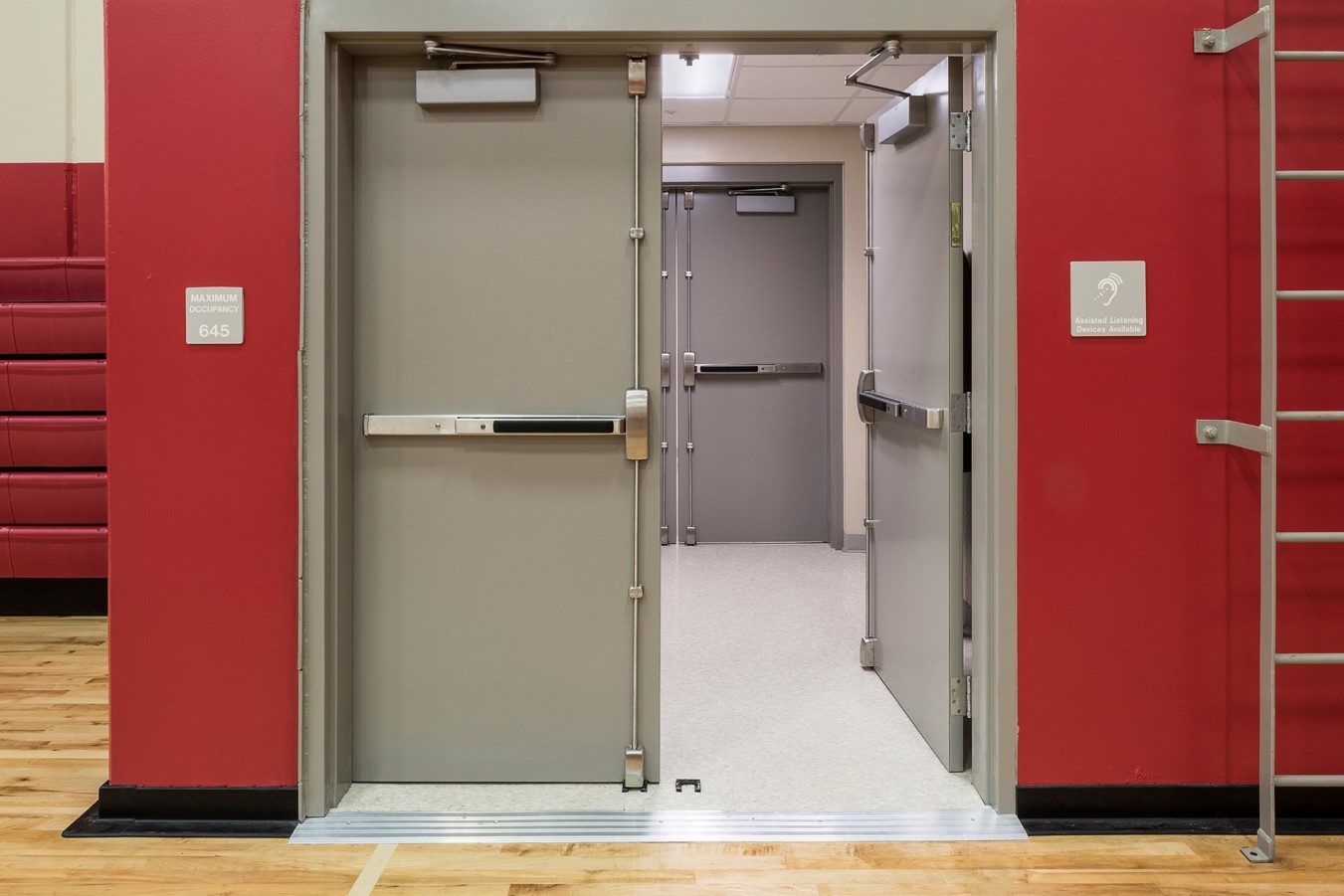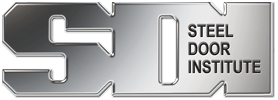Tips for Specifying Fire Door Assemblies

by Matthew Schumann, UL Solutions
Labeled fire door assemblies have been available for more than a century in the United States (U.S.). Fire door assemblies are complex systems featuring many individually certified components that, in combination, provide a specified level of passive fire protection. Fire doors act as closures for openings to limit a fire to a specific compartment, such as a hotel room or classroom, and help prevent the fire from spreading through the building. They may also have additional characteristics, such as thermal protection or severe weather or bullet resistance with varying performance levels.
Fire Door Assembly Essentials
A fire door assembly must include a means of positive latching. For steel fire doors, a minimum latch throw is required for doors not equipped with fire exit hardware. The minimum latch throw can impact the lock model and type used. Most openings will also require the installation of a door-closing device such as a hydraulic arm-type closer or spring hinges. Other components may include gaskets, seals, door bottoms, glazing, glass light frames and fusible link-equipped louvers. Fire door assemblies require all components beyond steel or stainless-steel leaf hinges to be listed and labeled, as the combination of these parts determines the fire rating for the opening. The lowest-rated component determines the doorway’s fire rating. Steel fire doors are often relied upon to help provide protection. Steel fire door constructions can include steel-stiffened, honeycomb, temperature rise and foamed insulation core options.
If a door assembly is to be fire-rated, consult with the door manufacturer, as certifications and performance levels may vary based on door width, height, core type and hardware used. Multiple hardware and installation methods are often permitted for some products. In contrast, other products are limited due to the testing conducted or listing, the more specific the application requirement, the more potential of limited product choices.
Building codes consider only products that bear a certification mark as labeled, and inspectors look for that label during inspections and building surveys. The most relevant codes for fire door assemblies are the International Building Code (IBC) (U.S.) and NFPA 101®, Life Safety Code®. NFPA 80, Standard for Fire Doors and Other Opening Protectives, governs fire door installation where testing is most often conducted per ANSI/UL 10C, the Standard for Positive Pressure Fire Tests of Door Assemblies, for hinged, swinging doors. Swinging fire doors receive fire ratings of 20 minutes, ¾ hour, 1 hour, 1½ hours and 3 hours. This hourly rating system replaced earlier rating systems featuring the letters A-E or various label phrases such as “fire door for opening in a vertical shaft.”. Frames may not have a fire rating stamped or marked, depending on the certification mark the manufacturer uses. When the door frame does not note an hourly rating, the hourly rating is typically understood to be up to 1½ hours maximum in drywall installations or up to 3 hours in masonry installations, however, the specific rating should be confirmed with the manufacturer.
Fire Door Hardware
Spending some time on door hardware is essential, as hardware choices can affect a door manufacturer’s ability to construct and label a door. Door hardware is a broad term that encompasses everything but the door leaf and frame. It may include door position switches and protection plates, among other miscellaneous accessories specified for installing fire doors and frames. Door hardware for fire doors is certified with various ratings for use on different fire doors. When the product doesn’t specify a rating, it is considered to have a 3-hour rating. If there are limitations on product use, the hardware’s published listing will provide information on those limitations. These limitations may be door width, door height, a lower fire rating and whether the product is limited to a specific door type. If no restrictions are present, the hardware has a 3-hour fire rating and can be used on steel doors up to 4 feet in width and 8 feet in height. This concept extends to bored locks, mortise locks, fire exit hardware devices of various types, and other two- or three-point lock or latch products.
Other commonly certified door hardware installed with fire doors includes electronically controlled single-point locks or latches (hotel locks, locks with card readers/keypads). These auxiliary locks include deadbolts, electromagnetic locking devices, electric strikes and door hinges. Some products may have multiple certifications, so selecting certified versions for fire door use is essential when reviewing templates and installation instructions.
Fire-rated door hardware may have limited functions compared to similar products not listed for fire door use due to the requirements placed on fire door assemblies. One typical example is panic or exit devices that often mirror fire-rated versions; however, due to differences in application, they may have different product features. Products labeled as panic hardware are not for use on a fire door assembly. Fire exit hardware indicates exit devices tested for fire doors and egress considerations. In contrast, the term “panic hardware” refers to a device that is only certified for egress.
Other similar considerations must be made with electric strikes in fire door assemblies since the strike must hold the latch bolt in the case of a fire. Electric strikes and electrified hardware add complexity due to the engineering and construction of the door or frame to accommodate the products and the related raceways and dust boxes. Finally, deadbolts and electromagnetic locks must constantly be reviewed with the building owner and the local authorities to gain their approval since they can actively limit egress through the doorway or may require additional devices to be installed.
Considerations for Specifying Fire Doors
Code language in the IBC and NFPA 101 tightly regulates fire doors assemblies, as does NFPA 80 for inspection and maintenance. These codes and standards state that fire door labeling can occur only at facilities under an ongoing label and follow-up program. This requirement for follow-up services means that the door or frame manufacturer will want as much information as possible from the customer to ensure that the products are manufactured correctly. Here are some considerations when planning for the purchase of doors and frames:
✔ Hourly Ratings
-
- What does the opening need?
✔ Labels
-
- What does the local jurisdiction require?
- Will metal labels be necessary?
- Do hourly ratings need to be present on the frame labels?
- Are there specific locations for the labels based on the type of building occupancy?
✔ Dimensions
-
- Are there accurate dimensions for the door panels?
- Will the door need additional hinges due to height, or does it require a steel overlapping astragal?
✔ Frame Details
-
- Do the frames need to be fully welded or is knock-down, field assembled corners sufficient?
- What type of wall?
- What type of anchors are needed?
- How many anchors based on the opening height and wall type?
- Have face width, jamb depth, and stop height been discussed?
- Single or double rabbet?
- Will there be a need for mullions, lights or panels?
✔ Glazing
-
- What is the size and maximum exposed area?
- Is it an integral glass frame or a separate glass light frame?
- Who is the manufacturer?
✔ Hardware
-
- Do the hardware fire ratings equal or exceed the rating of the proposed door?
- Are there special hardware reinforcements or installation requirements to discuss with the door manufacturer?
- Will any smoke seals, gaskets, thresholds or astragals be needed?
✔ Configurations
-
- Can a more straightforward hardware configuration be used?
- Are choices being limited by specifying certain products, configurations or performance levels for other attributes that may not be necessary?
✔ Door Use
- What is the intended use?
- Is a temperature rise door needed, or will a honeycomb door meet the code for the application?
- If the door has a temperature rise rating glazing, will the area of the glazing permit a temperature rise rating to be marked on the label?
While specific considerations may vary depending on application, reviewing these topics before engaging a door distributor or door manufacturer will help scope the correct specifications for the project. Another potential benefit is minimizing the need for rework or modification in the field to avoid additional job site inspections or evaluations. When a labeled door is delivered to a site for installation, the goal is to have the door ready to go and fully prepared for installing hardware and glazing.
A fire door assembly is more complex than one may think at first glance, but it plays a vital role. Additional steps in the specification and procurement stages can go a long way toward helping to ensure that there are many options for finding the proper steel door assembly to achieve the desired fire rating and level of performance required for the opening.
About the author: Matthew Schumann is a subject matter expert at UL Solutions for fire containment and fire resistance products, including fire doors and hardware. He has worked at UL Solutions for more than 20 years and has expertise in fire doors, glazing products and hardware.
